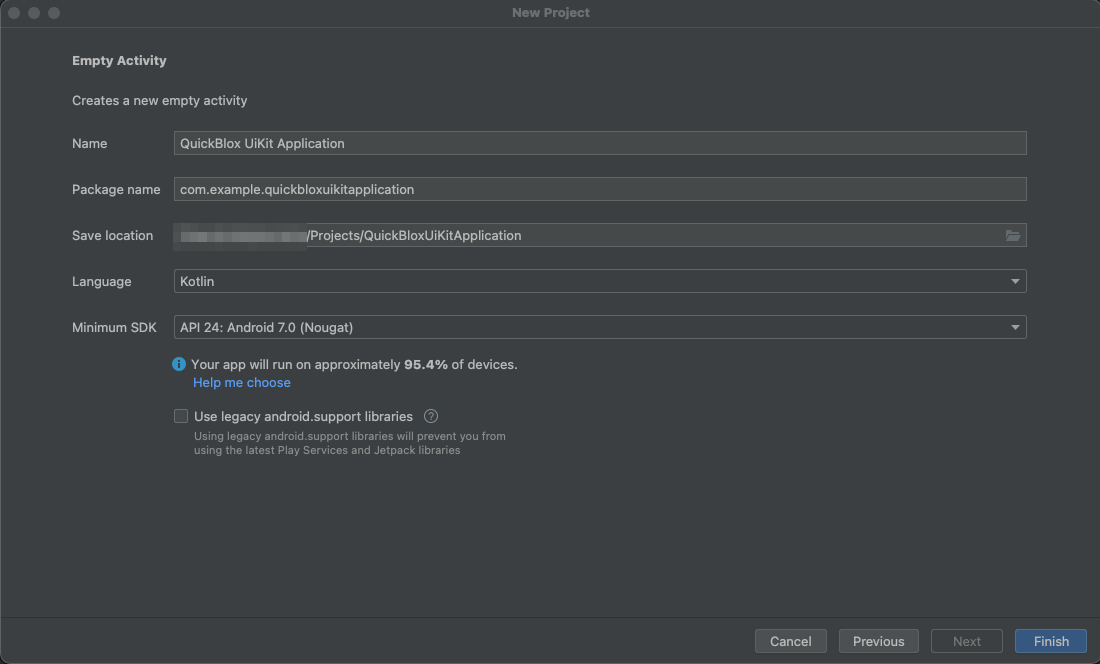Requirements
The minimum requirements for QuickBlox UIKit for Android are:- Android 5.0 (API level 21) or higher
- Java 8 or higher
- Android Gradle plugin 4.0.1 or higher
Before you begin
Register a new account following this link. Type in your email and password to sign in. You can also sign in with your Google or GitHub accounts. Create the app clicking New app button. Configure the app. Type in the information about your organization into corresponding fields and click Add button. Go to Dashboard => YOUR_APP => Overview section and copy your Application ID, Authorization Key, Authorization Secret, and Account Key .Get started
If you build mobile applications for the Android platform then you are no doubt already familiar with Android Studio, a popular tool and the official Integrated Development Environment (IDE) for Android app development.Step 1. Create a project
- Launch Android Studio
- Click “New project” button in the Welcome to Android Studio window.
- Select Empty Activity in “Phone and Tablet” Template window and click Next.
- Set your project name and desired configurations and click Finish.

Step 2. Install QuickBlox UIKit
There are 2 ways to install to QuickBlox UIKit from:- Repository
- Local source
Kotlin
Kotlin
Kotlin
Kotlin
Step 3. Init QuickBlox SDK
To initialize the QuickBlox Android SDK, we need to create a class for example name App and perform the initialization in the onCreate() method. The class App will inherit from the Application class to ensure proper management of the application’s lifecycle and provide a global context. The Application class is the base class for creating Android applications and serves as a container for global application states and settings. An application can have only one instance of the Application class, which is created by the system when the application is launched. By inheriting from the Application class, we can create a custom class App that extends the functionality of the base class. In the App class, we can override the onCreate() method, which is called when the application is launched, and perform the initialization of the QuickBlox Android SDK there. Thus, the App class becomes the entry point and control point for initializing and configuring various components, including the QuickBlox SDK, during the application’s startup. Also to init QuickBlox SDK you need to pass Application ID, Authorization Key, Authorization Secret, and Account Key to the init() method. How to get credentials is described in the Before you begin section.Kotlin
XML
Step 4. Authenticate and start QuickBlox UIKit
Before sending your first message you need to authenticate users in the QuickBlox system. You can read more about different ways of authentication by this link. In our example, we show how to authenticate users with login and password. After successfully sign-in, you need to initialize the QuickBlox UIKit by invoking init(applicationContext) method of the QuickBlox UIKit and start the Dialogs screen by invoking show() method of the DialogActivity from your Activity.Kotlin
Step 5. Send your first message
After successful authentication, you will be directed to the chat list screen. To send your first message, follow these steps:- Tap on the icon located in the top-right corner of the screen, specifically designed for creating a new chat.
- Choose the type of chat you want to create. You can select either a private chat or a group chat.
- If you selected a group chat, enter a name for the chat.
- Select the users with whom you want to create the chat and tap the “Create” button.
- After creating the chat, enter your first message and start sending it.